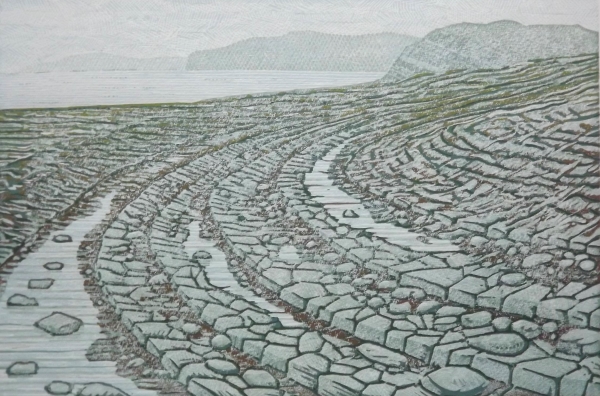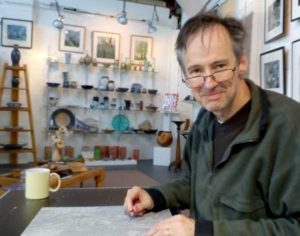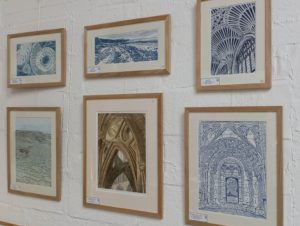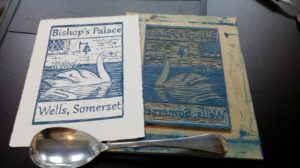Kilve Beach is on the North Somerset Jurassic coast within the Quantock Hills Area of Outstanding Natural Beauty (AONB). It’s a favourite spot for artists and geologists. The slanting strata exposed in the cliffs and on the foreshore are fascinating subjects. I was first introduced to Kilve Beach when my daughter returned from a school trip having found either a tiny crustacean or possibly part of a crinoid in a flake of weathered shale.
As a family we have visited many times and this has resulted in a series of prints, trying to do justice to the subject. The view out across the Bristol Channel, with South Wales in the distance was my first attempt to capture something of Kilve. The weathered and cracked stone pavement leading away to the sea, the rocks covered with seaweed and a headland visible in the mists across the channel.

For the “Paper Prospects” exhibition, I created a monochrome print of Kilve. The exhibition was a celebration of the uses of paper in printing and craft. It was the first print I’d done on St. Cuthbert’s locally made paper. It is fabulous paper to work with, it feels much more alive than other papers I’ve used. It is also nice to think that it is manufactured just down the road from where I live. I like to describe this print as a Somerset scene, by a Somerset artist on Somerset paper. I do generally prefer to make reduction prints, but monochrome prints are always an opportunity to use texture and pattern. They reduce everything down to ink or no ink and this tends to focus you on capturing the essence of things.

The action of the tides coming and going rearranges the beach, so each time you visit there are new things to see. It is like a constantly changing kaleidoscope of perfection. For some reason nature’s compositions are always more profound than anything an artist can imagine. In the next print I wanted to take a closer view, excluding the sky and focussing just on the rocks and shale.

Kilve is famous for its fossils and the most spectacular are the large ammonites, found on the shore at the western end of the beach. It’s important to remember that this is a Site of Special Scientific Interest and hammers are not allowed. This is a good thing, it means the fossils will remain there longer, for all to see, until nature slowly erases them. It also makes for a more peaceful, contemplative atmosphere, with none of the frantic hammering and clambering on battered cliffs that you see on the South coast. The ammonites are from the Jurassic, so they are over 145 million years old. This print is a combination of several fossils found at the beach. It’s a monoprint the different coloured inks are applied by hand to a single block.

Sometimes reduction prints don’t work out the way you hoped and this is an example. I had intended to create a print that focussed on the visible strata in the cliffs. Unfortunately, it just didn’t come out the way I wanted. When it was finished and I sat down to decide which prints could go into the edition, there wasn’t a single one that I was happy with. I think this is an experience every printmaker has, but mostly we don’t talk about it. Having invested several weeks into this one print I decided to make a collage. I cut the print into strips, arranged them in layers one on top of another and gave it the title of “Kilve Strata.” The moral of this story is, never give up, no matter what happens!

This is my final print of Kilve, at least for a while, and it’s a view looking East along the beach, with the blue lias cliffs disappearing into the distance and the curving beds of limestone and shale in the foreground.

My prints can be seen on my website.
I don’t sell reproductions of my prints, but I have made several greetings cards available from Love From The Artist.









